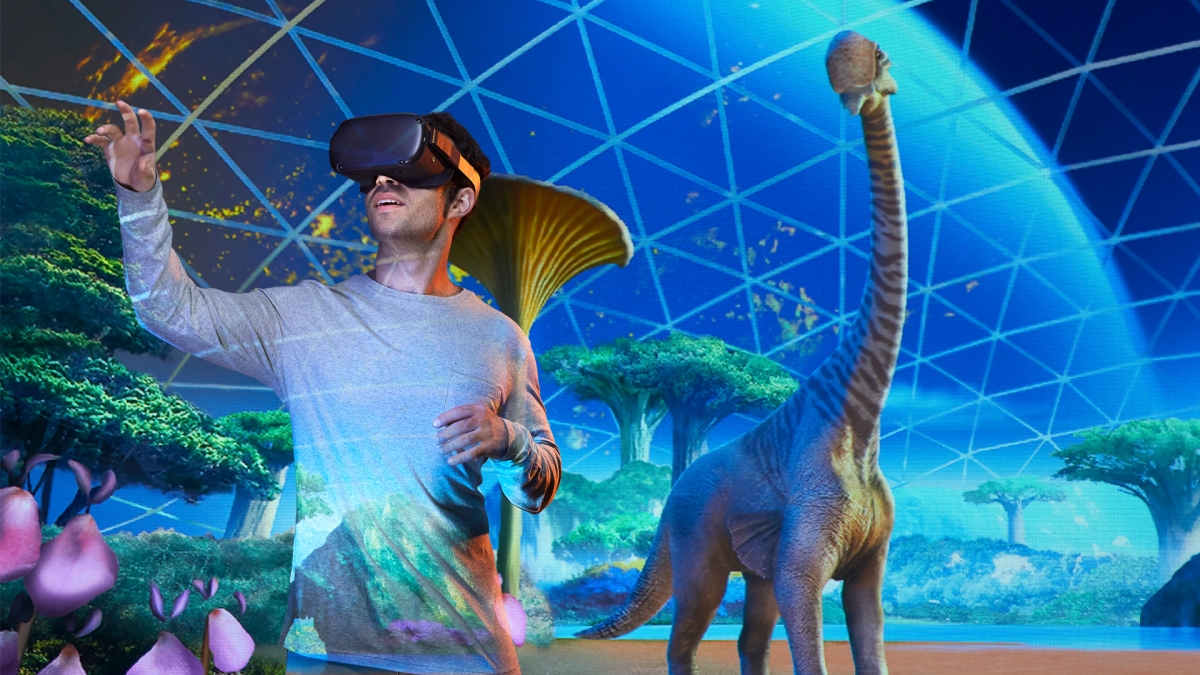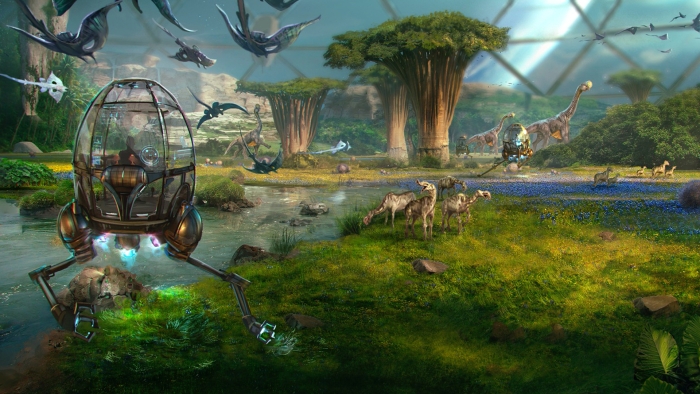Exploring new worlds in virtual reality

Alireza Bahremand, a graduate student working with the Dreamscape Learn team and Meteor Studio, explores the “Alien Zoo” module. Photo by Jeff Newton
Editor's note: This story originally appeared in the winter 2021 issue of ASU Thrive magazine.
Imagine you’re a biology student studying hundreds of unknown species and microscopic life forms. Traditionally, you would walk into a classroom with four walls and a chalkboard to begin your learning journey. But instead, you step into a 16-by-16-square-foot space with a moving floor and blowing wind. Once seated, you’re transported light-years away to an orbiting intergalactic wildlife sanctuary full of endangered life forms that need your help.
Inside the pod, as your avatar, you’re immersed in a new world. You’re working in a virtual laboratory with a plethora of fictional animal species that function based on biological laws. You can explore, discover, observe and experience numerous hands-on problem-solving tasks that you can’t dream of or do within a traditional classroom.
This isn’t a game; it’s ASU’s new virtual reality immersive biology curriculum called Dreamscape Learn, made possible through a partnership with Dreamscape Immersive. Based on the work of curriculum experts at ASU, students in the university and beyond will benefit from the new world order of education: VR immersive learning.
Technology has caught up with what people used to think about, and we can now build an emotionally driven learning experience to teach really complicated subjects.
Michael M. CrowASU president
VR learning can be much more powerful than lectures. A study from the University of Maryland showed that VR learning can improve recall by as much as 8.8% over traditional learning. A 2020 PwC report found that VR learners were four times faster to train than traditional classroom methods. But the bigger win is that learners were 3.75 times more emotionally connected to the content than classroom learners.
Immersive video arcade meets IMAX theater
In September 2020, something delightful was making its way to education. Seventy-five designers, coders and educators at ASU were collaborating to create the first immersive learning biology curricula on this planet as part of its new partnership with Dreamscape Immersive.
According to Heather Haseley and Dan Munnerley, co-executive directors of the Learning Futures Collaboratory, education needs to create VR learning experiences through gameful design — using the intrinsic and extrinsic motivators embedded in games.
And that is what ASU and Dreamscape Learn are doing, opening a portal through VR technology that transforms how students experience learning and shapes their learning pathways.
To transport students to this intergalactic wildlife refuge and preserve life that’s extinct from across the galaxies, teams at ASU and Dreamscape Immersive turned a physical space in the campus’s Creative Commons into an immersive learning creation and experience site featuring a multisensory VR experience for students. Step into the pod, put on a VR headset that’s tethered to a computer backpack, strap sensors on your hands and experience the myriad of haptic sensations, bringing the experience to lifelike realness. Or for students outside of the immersive studio, they will still experience the scientific journey into “Alien Zoo” in either 2D or 3D.
Buckle up, you’re about to learn by doing, as you hurtle through space to a one-of-a-kind wildlife sanctuary far off in another galaxy.
Creating authentic and delightful learning experiences
Except for the last few hundred years, almost everyone learned by doing, experiencing the world around them.
“This notion of immersive learning, emotional learning has been beaten out of the system, and now VR is the tool to reintroduce learning by doing into education,” said ASU President Michael M. Crow.
“Alien Zoo” emerged from a script created by Walter Parkes and Steven Spielberg that didn’t make it to the big screen. So what did these two legendary Hollywood producers do? They transformed it into an immersive experience available at shopping centers — and now are using it as a basis for learning.
Crow believes that delight has been missing from learning. “We haven’t been able to attach to the emotionality of pleasure and delight in learning — particularly in these generic subjects like math, science and history," he said. "Technology has caught up with what people used to think about, and we can now build an emotionally driven learning experience to teach really complicated subjects.”
In their 2020 “Virtual and Augmented Reality: Understanding the Race for the Next Computing Platform” report, Goldman Sachs identified nine use cases for VR and augmented reality that will drive market adoption; and education made the list with upwards of 15 million users by 2025 — but so did content creation for VR.
“Storytellers can make anything come to life, but in science, you have to be accurate,” Crow said.
That’s where Michael Angilletta comes in.
Angilletta is an evolutionary biologist who leans more toward Bill Nye the Science Guy than a college professor. Angilletta is passionate about biology and the possibilities VR can bring to students. In 2017, he helped create ASU’s first digital biology courses and never imagined he would work with Hollywood storytellers to create a VR curriculum.
Now, Angilletta and Parkes and his team are collaboratively creating the science VR storyline and curriculum for the university’s first immersive biology class experience.
“The goal is for students to learn to think like biologists and solve problems, and VR is the hook to make this happen,” Angilletta said. “The biology curriculum will encourage them to master the same skills and the same knowledge to solve similar problems on Earth. We want to raise students’ critical thinking skills by immersing them in this world.”
Angilletta believes the only way to get students engaged in using critical thinking skills is to create exciting novel problems they can solve. “We have to provide learning goals and a pathway to achieve those goals, plus tell a good story,” he said. “My focus is to create engaging, emotional storytelling and realistic biology.”
Back to learning by doing
Angilletta says that developing the first of 12 modules of biology curriculum with the studio’s storytellers was a constant back and forth between what would make a cool story versus what’s grounded in science and engaging in VR.
“What makes virtual reality training so engrossing and effective is the immersive nature of the experience, which simulates a classroom,” said PwC’s Scott Likens, an emerging tech leader.
Likens adds that when learners are immersed in VR training, they are not distracted by outside influences such as texts and emails — common occurrences during online and classroom courses.
In addition to improved recall, the learning costs can be reduced by using VR. The PwC study found that VR training achieved cost parity with a classroom at 375 learners.
“At 3,000 learners, VR training became 52% more cost-effective than classroom training, and it achieved cost parity with online courses at 1,950 learners,” Likens said.
So what does a compelling, emotional story grounded in science look like in a VR curriculum in “Alien Zoo” on another planet?
“Imagine an animal eating another animal, and you have to do a ‘CSI’ thing and find out what ate it and how that affects the species,” Angilletta said. “Think about a population with a transmittable disease, like contagious cancers; they are rare on Earth, but they do exist, so as a biologist in this world, you’re concerned because you have to manage a population, not one individual, and that could affect the whole ecosystem.”
Angilletta says a student will walk away from ASU’s VR immersive learning with transferable skills like problem-solving, quantitative reasoning and collaboration.
“Sign up for 11 a.m. VR, go into the pod and off to your corner or meet up with other biologists (in the virtual world) to work together solving critical species survival problems,” he said.
Likens adds that VR’s simulations and immersive experiences also draw learners’ eyes to the content and better capture users’ attention.
“In the PwC study, VR-trained learners were up to four times more focused than people who took online learning and 1.5 times more focused than those trained in a classroom,” said Likens. “When learners are immersed in a VR experience, they tend to get more out of the experience and are likely to have better outcomes.”
Back to the future
“Imagine you’re in a classroom with a chair behind a desk that’s bolted to the floor. That ‘technology’ for how you sit in the room determines everything, it’s a fixed mode of learning,” Crow said.
But in the VR world, learners will shift from a passive approach to a more active approach of working through problems in groups.
Crow says ASU isn’t stopping with the VR curriculum for biology but plans to create VR immersive learning curricula for all of its subjects, from architecture to nursing.
“What we’ve been trying to do is find ways to create more learning pathways than the ‘desk bolted to the floor,’” Crow said. “If we accept the model that there are multiple types of intelligence — emotional, tactile, spatial, verbal, etc., then why is our entire college system built on only two — verbal and analytical?
“With VR/Dreamscape Learn, we are coming full circle and getting back to how we were naturally meant to learn — how we learned for thousands of years — with more emotional attachment.”
Written by Jennifer Kite-Powell.
More Science and technology

Programming to predict the unpredictable
As the natural world rapidly changes, humanity relies on having reliable, accurate predictions of its behavior to minimize harmful impacts on society and the ecosystems that sustain it.Ecosystems of…
Findings on adenoviruses in baby gelada monkeys provide a window into our own cold and flu season
If you have young kids or spend time around day care centers, you know the drill: Someone gets a cold, and soon the whole group is sniffling and sneezing. Now imagine that same pattern playing out in…

Student teams create AI tools to help neurodivergent learners
When Stevie Cervantes was a first-year student at Arizona State University, she shied away from using AI.“AI was everywhere and my friends were asking me, ‘Oh, do you use ChatGPT?’ And I hadn’t even…

